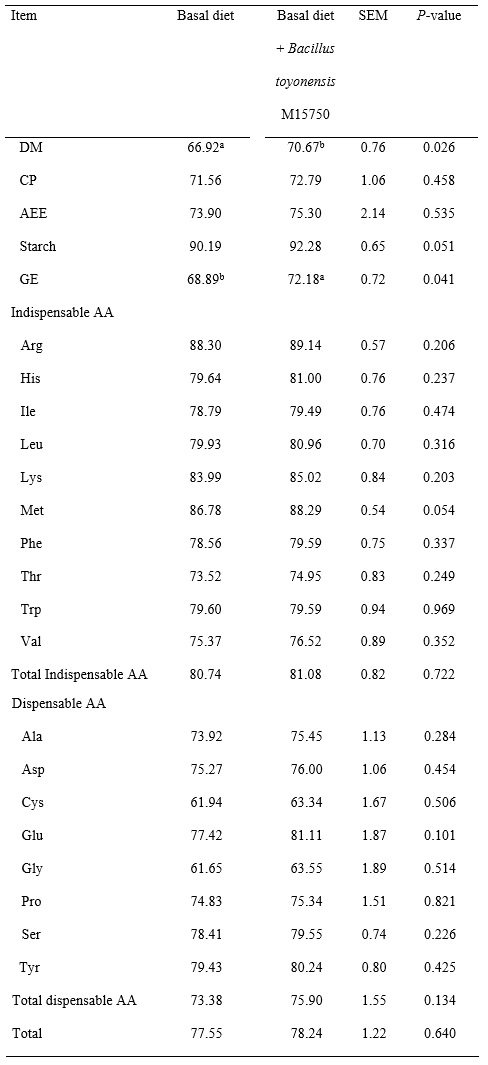Addition of probiotics to swine diets may improve gut health by modifying the microflora, which may help control pathogens, enhance immune response, and increase nutrient digestibility. Once consumed by the pig, probiotics enter the stomach where they are subjected to a low pH and pepsin. The Bacillus strain are metabolically inactive spores that are thermostable and survive at a low pH and, therefore, are thought to survive feed processing and digestion in the stomach. Addition of a Bacillus strain may enhance fermentation of dietary fiber in swine diets and, subsequently, increase the available energy from the diet in the form of volatile fatty acids. Bacillus strain also may degrade non-starch polysaccharides to reducing sugars that may serve as an energy source for the pig. A novel probiotic Bacillus toyonensis M15750 has been developed, but there are limited data to demonstrate the efficacy of this probiotic to increase nutrient digestibility. Therefore, an experiment was conducted to test the hypothesis that probiotic Bacillus toyonensis M15750 improve the apparent ileal digestibility (AID) and apparent total tract digestibility (ATTD) of energy and nutrients when included in diets fed by weanling pigs.
Animals, Housing, Experimental design, and diets
A control diet was formulated based on corn, soybean-meal, and distillers dried grains with solubles and a second diet was formulated by supplementing the probiotic Bacillus toyonensis M15750 to the control diet. Vitamins and minerals were included in all diets to meet or exceed the estimated nutrient requirements for weanling pigs (NRC, 2012). Titanium dioxide (0.50 %) was added to the diets as an indigestible marker.
Sixteen weanling barrows (10.7 ± 0.7 kg) that had a T-cannula in the distal ileum were allotted to the two diets with 8 replicate pigs per diet in a randomized complete block design with body-weight being the blocking factor. Feed was supplied in meal form and pigs were limit fed daily at 3.2 times the maintenance energy requirement (i.e., 197 kcal of ME/kg of BW0.60; NRC, 2012) of the smallest pig in each replicate. Pigs were fed experimental diets for 14 days. The initial 7 days were considered an adaptation period to the diets. On days 8 and 12 in the morning, a color marker was included in the feed. Fecal collections were initiated upon appearance of the first color marker in the feces and ceased upon appearance of the second color marker using the marker to marker approach (Adeola, 2001). Urine collections started 2 hours after feeding the morning meal on day 8 and ceased 2 hours after feeding the morning meal on day 12. Ileal digesta were collected for 8 hours on days 13 and 14. A 225-mL plastic bag was attached to the cannula barrel using a cable tie and digesta flowing into the bag were collected. Bags were removed every 30 min, or whenever full, and replaced with a new bag. Ileal digesta were stored at - 20oC immediately after collection.
At the conclusion of the experiment, diets and ileal samples were analyzed for dry matter, gross energy, crude protein, amino acids (AA), acid-hydrolyzed ether extract (AEE), and starch, and AID was calculated (Stein et al., 2007). Dry matter, AEE, and total dietary fiber (TDF), were analyzed in diets and fecal samples. Gross energy was also analyzed in fecal and urine samples, and the ATTD was calculated (Adeola, 2011). Values for digestible energy (DE) and metabolizable energy (ME) were calculated as well (NRC, 2012).
Results
No differences in daily feed intake, dry matter intake, and gross energy intake were observed between treatments (Table 1). Excretion of gross energy and other nutrients in feces was not influenced by dietary treatment and ATTD of dry matter, gross energy, AEE, and TDF were also not affected by inclusion of the Bacillus toyonensis M15750 in the diet. Therefore, digestible energy and metabolizable energy were not different between the two treatments.
Apparent ileal digestibility of dry matter and gross energy was greater (P < 0.05) in the diet supplemented with the Bacillus toyonensis M15750 compared with basal diet (Table 2). In addition, the AID of starch tended to be greater (P ≤ 0.05) in the diet supplemented with the Bacillus toyonensis M15750 than in the basal diet. However, the AID of crude protein, AEE, and most of AA was not different between basal diet and diet supplemented with the Bacillus toyonensis M15750, with exception for AID of Met that had a tendency to increase (P ≤ 0.05) if the Bacillus toyonensis M15750 was included in the diet.
Key points
- The probiotic Bacillus toyonensis used in this experiment, increased the AID of dry matter, gross energy, and had tendency to increase AID of starch in the diets.
- No differences were observed for the ATTD of energy or nutrients between the 2 diets, which indicates that the increased digestibility in the small intestine of pigs fed the diet supplemented with Bacillus toyonensis M15750 was offset by a reduction in hindgut fermentation.
- These results indicate that inclusion of probiotic Bacillus toyonensis M15750 in diets for weanling pigs have the potential to improve the AID of gross energy and starch.
Table 1. Apparent total tract digestibility (ATTD) of gross energy (GE), dry matter (DM), acid hydrolyzed ether extract (AEE), and total dietary fiber, and DE and ME in diets without or with the Bacillus toyonensis M157501
1Data are means of 6 observations for the basal diet and 7 observations for the diet with the Bacillus strain.
2IDF = insoluble dietary fiber; SDF = soluble dietary fiber; TDF = total dietary fiber.
Table 2. Apparent ileal digestibility (AID) of dry matter (DM), crude protein (CP), acid hydrolyzed ether extract (AEE), starch, and amino acids (AA) in pigs fed diets without or with a Bacillus toyonensis M157501

a-b Means within a row lacking a common superscript letter are different (P < 0.05)
1Data are means of 6 observations for the basal diet and 7 observations for the diet with the Bacillus strain.